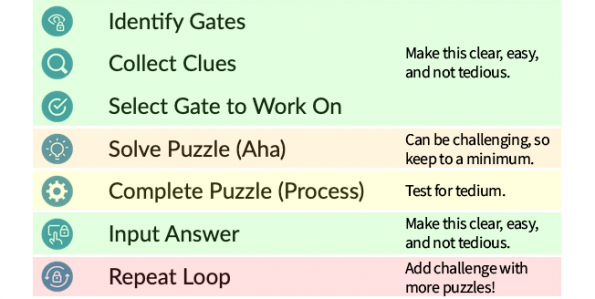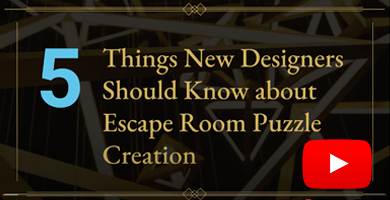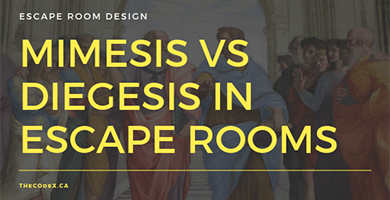If I’m about to do an escape room, and they ask if I want to raise the difficulty, I refuse.
Why? Because I don’t trust the designer! I can’t even expect the industry to produce well-designed escape rooms, let alone one that’s difficult. When escape rooms try to increase the difficulty, more often than not, they just raise the tedium. A puzzle doesn’t get harder to solve, it just takes longer to do.
Not that I blame designers. Creating a fair and difficult puzzle is challenging! Trust me. I know. I’ve spent months creating difficult puzzles, only to suffer the aftermath of profanity and voodoo dolls in my mailbox.
But the tedium? That’s easy to increase, and there are so many places to do it!
What places, you ask? Well, this is where the Player Loop comes in.
Back in May, 2019, I gave a seminar on escape room game flow at the Escape Summit where I introduced the Escape Room Player Loop. The purpose was to highlight areas in the experience curve where frustration can occur.
If you can decrease the frustration in the player loop, then you can better manage the experience in your escape room. It just so happens this also coincides with what not to make difficult in your design.
Terminology
First, let’s define a few terms.
Gate: A surmountable obstacle that prevents the team from progressing in the game. This can be a door, a lock, a puzzle, a dexterity challenge, an actor, the expanse of time, ignorance, anything that bars access. When implemented in a game, designers refer to this mechanic as gating.
Clue: An in-game item and/or piece of information required to surpass a gate. Examples include a key, passcode, part of a solution to a puzzle. This is defined here to differentiate from a hint: out-of-game information designed to help the player advance, but not required to complete the game.
Signifiers (Signposting): Obvious or subconscious clues within the game directing the players on what to do next. For example, if a puzzle is solved, a light can come up indicating the next gate to be solved. The video game industry refers to this as signposting, but this tends to give the wrong idea that players need to be handheld throughout the game.
The Player Loop
The player loop breaks up what a team does in an escape room. This does not mean, however, that every step is necessary. Nor does it mean each player is on the same step at the same time with their teammates. Furthermore, you can have nested loops.1
| Identify Gates | ||
| Collect Clues | ||
| Select Gate to Work On | ||
| Solve Puzzle (Aha) | ||
| Complete Puzzle (Process) | ||
| Input Answer | ||
| Repeat Loop |
Identify Gates
![]() When a team first enters an escape room, they have to figure out where to start. They search the room, they look for locks, they look for objects to interact with, etc. Questions asked during this time usually are “What needs to be opened?” or “What haven’t we solved?”
When a team first enters an escape room, they have to figure out where to start. They search the room, they look for locks, they look for objects to interact with, etc. Questions asked during this time usually are “What needs to be opened?” or “What haven’t we solved?”
Collect Clues
![]() While players explore the room, they will find clues that will help solve puzzles. They may find a key to open a chest. They may find multiple objects that clue to a password for a word lock. Players collect these clues or keep note of them if they are immovable.
While players explore the room, they will find clues that will help solve puzzles. They may find a key to open a chest. They may find multiple objects that clue to a password for a word lock. Players collect these clues or keep note of them if they are immovable.
This can be done at the same time players are Identifying Gates.
Select Gate to Work On
![]() At some point in time, players need to start working on a puzzle. Sometimes it’s obvious: “This heart key goes with heart lock!” and in a linear game, there isn’t much “selecting” that happens.
At some point in time, players need to start working on a puzzle. Sometimes it’s obvious: “This heart key goes with heart lock!” and in a linear game, there isn’t much “selecting” that happens.
However, in a game that has multiple puzzles or multiple clues presented to them, the players will ask two questions:
- Which clue goes with which puzzle?
- Do I have enough clues to solve a puzzle?
Once they find a satisfactory answer to those questions, they can choose a puzzle to work on.
Solve Puzzle (Aha!)
![]() Players need to correlate clues and figure out how a puzzle needs to be solved, aka the Aha!
Players need to correlate clues and figure out how a puzzle needs to be solved, aka the Aha!
For example, imagine the players need to open a vent which is screwed to the wall. There is no screwdriver anywhere in the room, but there are coins. The Aha happens when players correlate the flat edge of a coin to the slot drive of a screw! The coin can be used to open the vent.
Not every puzzle has an Aha! aspect: getting a key and unlocking its door doesn’t require an Aha unless someone is completely unfamiliar with key mechanics. For more information on Aha, please see the article “Puzzles: Aha! Vs Process”.
Complete Puzzle (Process)
![]() This step is when the players know what to do with a puzzle, and now must put in the work to complete it.
This step is when the players know what to do with a puzzle, and now must put in the work to complete it.
Going back to our previous example, the player has figured out the coin can be used to unscrew the vent and now they must go through the process of unscrewing all the screws. (While they are doing this, someone will inevitably come over and say, “Hey! You can use these coins to unscrew that!”)
Not every puzzle has a process stage to it, but most do. For more information on a Process puzzle, please see the article “Puzzles: Aha! Vs Process”.
Input Answer
![]() Once the puzzle is solved, sometimes an answer must be inputted. For example, a keycode on an electronic number pad, a password on a computer, a combination on a lock.
Once the puzzle is solved, sometimes an answer must be inputted. For example, a keycode on an electronic number pad, a password on a computer, a combination on a lock.
Again, not every puzzle requires an answer to be inputted. The above coin / vent puzzle doesn’t require an inputted answer.
Repeat Loop
![]() Once a gate is surpassed, more clues and gates may be revealed. Or maybe more clues for an existing gate. Regardless, the loop repeats again until the final gate is opened, or the players lose the game and are laughed at by their peers.
Once a gate is surpassed, more clues and gates may be revealed. Or maybe more clues for an existing gate. Regardless, the loop repeats again until the final gate is opened, or the players lose the game and are laughed at by their peers.
Don’t Make These Difficult
Ok! With the player loop now in hand, I can now go into obsessive detail on why I die a little inside when owners brag about their 1% escape rate.

Don’t Make it Challenging to Identify Gates or Collect Clues!
This is normally search related. I am not against searching. I think searching is perfectly fine in an escape room, even if I personally am not a fan of it.
However, don’t make the searching hard! Yes, I admit I’ve had horrible search fails in my escape room life which are completely my fault, but there have been rooms where the secret panels are a bit too secret and there’s nary a thrown bone in sight.
This is even worse when you don’t even know what you’re searching for, or how long you need to search. Counting puzzles combined with searching is the worst.
Furthermore, don’t make it tedious. Sure, people love those “hidden object” games, but even then they get a list of what to look for and a ‘ding’ when they find it. Don’t make us play “Am I Getting Hotter?” with the game master. I used to do that with my kids and it wasn’t fun then either.
Oh, and not giving enough flashlights so I impatiently stand in the dark waiting for people to find things? Maybe just stop making escape rooms. Yeah, I said it. I hate that so much.
Make it Clear Which Gates can be Worked On!
Remember, this stage has two questions players will ask:
- Which clue goes with which puzzle?
- Do I have enough clues to solve a puzzle?
If players can’t answer those two questions because of ambiguity, then they become frustrated. Ambiguity is not fun. That’s Rule #2.
Let’s say you hate people. You’ve made a difficult logic puzzle for your escape room, and you’ve hidden each rule separately and did not indicate how many rules there were.
If the players get stuck on the logic puzzle, they’ll ask, “Can I solve this puzzle now, or do I need to search more?” If given no direction, there is the potential to waste a lot of time and increase frustration.
To be honest, one of the reasons I penned Rule #7 was because designers seemed to enjoy leaving the “Do I have enough clues to solve a puzzle” question unclear.
Rule #5 was written to cover the first question: Which clue goes with which puzzle?
Preferably, I’d like to work on “How does this clue fit with this puzzle,” as opposed to “Do I even have the right clue?”
Difficult Aha Puzzles Are Most Euphoric but Challenging to Do Well
When an escape room enthusiast wants a difficult room, this is where a fair and difficult puzzle is most rewarding to solve. If done well, this is where players will think, “Why didn’t I see that?!”
As a puzzle designer, I ACHE to come up with an elegant and unique Aha puzzle. As an enthusiast, when I solve a satisfying Aha puzzle, the reward is far sweeter than puzzles of pure process and overshadows everything else in the room!
However, if you put too many Ahas in an escape room, you shut out the mainstream crowd. Remember, everything is an Aha to a newbie. They’re so adorable.
Don’t Make Process Puzzles Too Tedious!
Escape room designers love upping the difficulty in the process part!
Are players unscrewing a vent too quickly? Let’s double the amount of screws!
Are players solving the logic puzzle too fast? Let’s make the logic puzzle harder!
Are players solving the Towers of Hanoi too quickly? Add more rings!
Don’t do that. Please. Yes, I understand one player’s tedium is another player’s ecstasy, but that doesn’t give you an excuse to design for the outlier. Again, Rule #7 was written for the case where no one enjoyed the tedium.
I don’t mind spending more than five minutes on a puzzle if it’s a well-designed puzzle. I’ve done plenty that have taken me longer and I loved every minute of it.
I find, however, that some designers increase the process difficulty to slow down the players. Slow us down with more puzzles. Don’t slow us down with tedium.
As with everything, player feedback is key. Listen to what your players say, and don’t just listen to the positive outliers.
Let Me Solve the Puzzle, Not the Lock
Sometimes it’s overly difficult to input the answer. Designers don’t make this difficult on purpose (I would hope). It’s usually just a problem with the tech or the props.
Or possibly not enough flashlights. (Yes, I hate being restricted flashlights. Fight me.)
Regardless, don’t make it difficult to enter a combination. Or unlock a door. Or enter a passcode.
Rule #4 was created in case this part does break down. At least the players know they are on the right track and are not waylaid because of failures in your maintenance department.
Add More Puzzles to Increase Loop Repetitions
Some designers increase the difficulty of the escape room by putting in more puzzles. Honestly, I don’t find anything wrong with this.
Enthusiasts have complained there aren’t enough puzzles in an escape room. Rare is it to see them complaining there are too many puzzles.
Of course, I’m not saying this is easy. Don’t just throw random puzzles in for the fun of it. If you want to make the game difficult, add in a longer experience with puzzles well integrated into the game flow.
This, however, is a different discussion.
Caveats
I probably should have placed this section close to the beginning for those who don’t wish to read the entire article.
If a fair and well-designed puzzle breaks the rules, then that’s great! The point of this article is to combat lazy design. Remember, the loop can be nested: there are times when steps in the player loop are puzzles themselves, thus making them more “difficult”.
For example, identifying a clue may be part of a puzzle. If there is an Aha required to notice the clue (and this Aha makes sense and is well designed) then this “difficulty” would be fine. Similarly, inputting an answer could also be considered a puzzle. As long as it’s been thought out, designed, and tested, then do whatever you want!
Except for red herrings. Notice it’s not clear where it fits in the loop? That’s because it doesn’t. Leave that in the trash where it belongs.
In Conclusion
When I see other people discuss how to rate the difficulty of a room, I bite my tongue. I know that further discussion will take up at least six pages in Google Docs. And this is without diagrams.
Unfortunately, you may have noticed this article did not cover how to make a properly difficult puzzle, it only highlighted where not to add difficulty. Making a fair and challenging puzzle is another article on its own and probably longer than this one.
Still, you can see why I am wary of “difficult” rooms. It will always mean “tedium” to me. If you ask me, they should have a “tedium” rating instead of a “difficulty” rating, but I bet that won’t get traction.
In the end, the industry is moving towards less difficulty anyway. If you really want to add more difficulty to an escape room, just add more fun puzzles.
NOTE: Thanks to those who helped proofread my article: Manda Whitney, Sarah Willson and Margaux Yiu.
Footnotes
- You may have noticed some steps in the player loop could be contained within other steps. For example, Collect Clues could be part of the Complete Puzzle (Process) step. Why? Because a gate can be as simple as having no clues to continue, and the searching could be considered a process. Input Answer could also be part of the Complete Puzzle step. They are separated here to specifically highlight areas where difficulty should not be increased.



Michelle
This is everything we believe in – and so well put. I’ll be sharing this with people who come to up for help on puzzle design. Great job!
Errol
Awesome! I’m glad it makes sense! 😀
Jim
Loved the article, Errol. In fact I love all your articles, in part because your analytical escape room critiques (and the Spiras) have helped me build two very successful escape rooms, so thanks, and thanks and thanks!
I want to ask you a specific question on a process puzzle in my latest room that gives my guest too much trouble, but “My name is Errol. The best way to get a hold of me is in our Enthusiast Slack Chat:” I can’t find Slack Chat. Where is it hidden? Is it a red herring? do I need to search better? did I miss an obvious clue? Is my computer malfunctioning? Clue please.
Errol
Oh gosh, I just realized I didn’t see this comment, I’m so sorry. I hope you found it! It’s on the main page. In the green on the right.
andrei astilean
so you would say that easier puzzles and with longer search is more ideal? i am asking because some of the customers tend to get frustrated in the search of clues. even thought its not the same puzzle each time.
Errol
Honestly, it depends on your customer base. I, personally, wouldn’t want a longer search time, but then that’s me and my personal preference. If your customers aren’t enjoying searching, then that’s a good indication to try something else.
Escaper
Well said) But I still love solving puzzles – this is my favorite part of completing quests)
Stein Strindhaug
So you’re saying that the escape room I went to once where we spent probably 10 minutes figuring out the mechanics of releasing the handcuffs we started with and then spent 40+ minutes looking for any indication of a 3 digit code in all the set decorations which included dozens of books and some weird pegboard with some pegs missing which the group I was with consisting of overthinking software developers kept trying to decode as binary, only to have the game master unpromptedly tell us how to open the next room because we were running out of time only to find another impossible puzzle with dozens of ropes and pulleys with no apparent function which we only got to fiddle with for less than 5 minutes before we ran out of time and the game master came in and couldn’t even get the ropes and pulleys puzzle to work when he tried to demonstrate it;
was a badly designed escape room?
It certainly was really frustrating and boring. And made me never want to try that crap again.